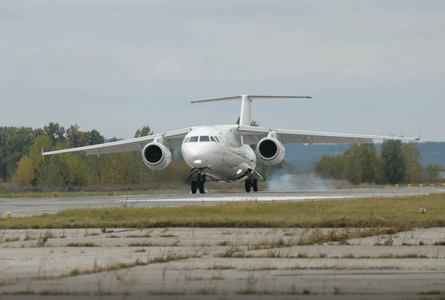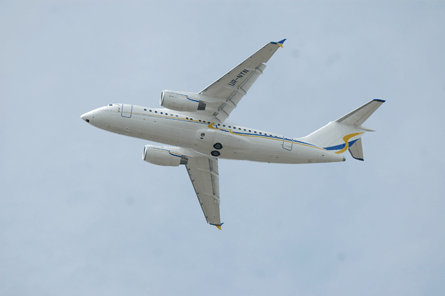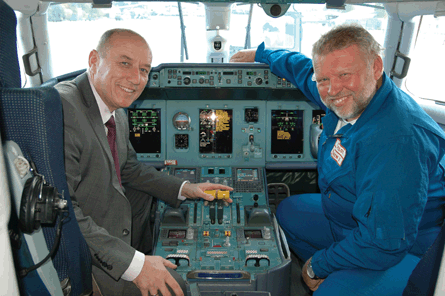Past glories do not secure or fund the future of any aircraft company within today's highly competitive aerospace marketplace. Ukrainian stalwart Antonov sought to rise to the challenge, starting in 2004, by designing and producing the An-148/158 regional jet as a completely new, clean-sheet aircraft, with full fly-by-wire (FBW) flight controls, a two-man flightdeck, a digital electronic flight information system (EFIS) glass cockpit and modern avionics.
 |
|---|
| © Vladamir Karnozov The type uses two Ivchenko Progress D-436-148 turbofans |
The An-148, which can carry up to 85 passengers, was certified in February 2007, and certification of the longer An-158 - which can hold 99 passengers - was secured in February of 2011. The two share a lot in common and have been certified under AP-25 regulations (Eastern European/Russian Interstate Aviation Committee), and are also fully compliant with the equivalent US Federal Aviation Administration FAR-25 and European Aviation Safety Agency CS-25 regulations. They also meet International Civil Aviation Organization regulations with regard to engine emissions, noise and cockpit security. The An-148 entered revenue service in 2009.
In October, I was granted the opportunity to be the first Western pilot to evaluate the newly certified An-158, in Kiev.
The An-158 uses two Ivchenko Progress-designed D-436-148 turbofans, with full-authority digital engine control (FADEC) and de-rated to each generate 15,000lb thrust (67kN). Engine start is by auxiliary power unit air. Maximum airport operating elevation is 3,000m (10,000ft), with clearance to 13,000ft under test; maximum crosswind is 30kt 56km/h) and the operating ground temperature range is -55°C ( -67°F) to 45°C (113°F). Service ceiling is 40,000ft and maximum speed is 470kt. Maximum take-off weight (MTOW) is 96,140lb (43.7t) and maximum landing weight is 83,160lb (37.8t). Quoted field length required at MTOW (sea level, international standard atmosphere) is 2,000m (6,600ft).
The aircraft is certified as compliant with required vertical separation minima, P-RNAV (RNP-1), B-RNAV (RNP-5), with Cat IIIA instrument landing system (ILS) autoland. The five 6in x 8in EFIS displays (Russian) support terrain awareness and warning system, traffic collision avoidance system, airborne communications addressing and reporting system, and wind-shear detection/guidance. Navigation/communications include GPS/GLONASS satnav data feed to double flight management systems (FMS) - supplied by Rockwell Collins - with individual trackball units for on-screen data input by each pilot; and double radio management units (RMUs) supporting 8.33 kHz VHF radio spacing, HF radios and a cockpit voice recorder (CVR). The An-158 retains high commonality with the An-148 in its fuselage, engines, major systems, training, documentation and maintenance. The fuselage of the An-158 is 1.7m longer than the An-148, and its wings, of the same dimensions, are equipped with winglets which, says Antonov, combine to give the An-158 an 8.5% improvement in fuel efficiency over the An-148.
 |
|---|
| © Vladamir Karnozov Peter Collins flew the An-158 from the Antonov test base at Gostomel, northwest of Kiev |
Antonov is justly proud of the An-148/158's FBW flight control system, which was designed in-house. The airliners are the first designed in the East to utilise the technology, says Antonov. The FBW fitted is digital and four-channel, signalling hydraulic actuators at ailerons, elevator and rudder. The wing is slatted, with flight spoilers that double as automatic lift dumpers on landing. The An-148/158 FBW system has a pilot-selectable mechanical back-up in the event that two or more FBW channels are lost. Antonov's philosophy with its FBW is for the system to be slightly simpler and to replicate to the pilot the control characteristics of a conventional aircraft rather than the more complex, Airbus-type FBW philosophy, in which the computer can limit certain pilot demands through a more complicated set of control laws.
Internal cabin width of the An-148/158 is 3.13m (10ft 3in) and the internal headroom 2.00m (6ft 7in), making it markedly wider than its competitors and allowing for much larger overhead bins. The high-set wing structure does not impinge on the internal cabin. The ultra-modern cabin itself is equipped with first-class seating in a 2+2 layout or economy seating in a 3+2 layout, with forward and rear galleys and overhead drop-down flat TV screens for in-flight entertainment. The An-148/158 has two under-floor cabin compartments, again larger in volume than any of its competitors; two passenger doors on the left side of the fuselage, with the forward door having integral steps; and two service doors on the right side. All this combines to allow the aircraft to rapidly de-plane/re-board passengers and be serviced and turned around from both sides and from all four corners simultaneously.
My evaluation took place at the Antonov test base of Gostomel - elevation 517ft - situated northwest of Kiev. The evaluation aircraft, registered UR-NTN, was the Antonov An-158 engineering and certification prototype, which had formerly been an An-148, but was lengthened for development, using fore and aft fuselage plugs, and re-equipped with the An-158 winglet configured wings. I was assisted by Sergey Troshin, Antonov's chief test pilot, in the right-hand seat, and Andrey Spasibo, project test pilot, in the central jump seat. I would fly the complete sortie from the left-hand seat after a very short introductory briefing. Field conditions were dry, outside air temperature 12°C (54°F) and QNH 1,012hp. The aircraft's basic operating weight was 25,500kg (56,100lb) and, with 5,600kg (12,300lb) of fuel, our take-off weight was 31,100kg (68,400lb). The aircraft was configured with a Russian cockpit.
A quick external visual inspection indicated that the standard of the surface finish was high - aluminium as the main structure and extensive use of carbon fibre for ancillary panels - and on par with Western standards. The cockpit was wide and bright, and featured sliding forward side windows. It was finished in the classic Russian panel background of pale blue/green, and gave the instant impression of being modern and uncluttered. Adhering to the "dark cockpit" philosophy, the flightdeck with its five large EFIS displays, glareshield-mounted autopilot/flight director-flight guidance panel (AP/FD-FGP) and pilot flying display-display control panel (PFD-DCP), was, again, instantly recognisable to me as totally equivalent to many other modern EFIS-equipped airliners and large corporate jets that I have flown. Despite the FBW system, Antonov has elected to use a conventional central yoke control for each pilot.
The central EFIS screen is primarily used as the multifunction display (MFD) containing engine information, trim indicators, aircraft door status, electronic normal, abnormal and emergency checklists, and aircraft system synoptic pages. An enhancing feature was that, for an abnormal or emergency warning, pressing the glareshield mounted amber or red "attention-getter" buttons automatically re-configured the MFD for the relevant system and posted the relevant checklist. The EFIS displays were bright, very well focused and logically laid out with respect to colour (for AP/FD modes) and displayed data. The "outside" display on each side, used as the PFD, supported two extra flight gauges for angle of attack and g, another enhancing feature in my opinion, and one I wish other EFIS manufacturers would consider. The An-148/158 presently does not have FMS vertical navigation (VNAV) modes or GPS approach modes, but Antonov states that these features are being prepared.
 |
|---|
| © Vladamir Karnozov Antonov chief test pilot Sergey Troshin and Flightglobal test pilot Peter Collins onboard an Antonov An-158 |
Engine start was simple, each engine taking less than 45s to stabilise and the associated checklists - pre-start, post-start and take-off - were short and rapid to action, just as it should be in any hardworking regional jet. The parking brake, as a small electric switch, was another neat design feature. Coming off the chocks, the aircraft felt powerful and, although equipped with a nose-wheel steering tiller, the rudder pedal steering was so effective that all normal taxi turns, even through 90 degrees or more, were easily and very accurately completed using just the rudder pedals.
BRISK ACCELERATION
Prior to line up, the take-off configuration warning was checked. Take-off speeds of V1 111kt, Vr 114kt and V2 119kt, at flap 10, were entered into the FMS and displayed on the PFD vertical speed tape. With the power levers slammed up to the stops from idle, take-off acceleration was brisk. I estimated the take-off roll at around 1,000m. Rotate forces were small. Initial climb rate was 3,000ft/min at 295km/h as we climbed towards FL300. At around 400ft above ground level, the throttles were retarded back to a setting of 63 degrees power lever angle, as indicated on the MFD, and the autothrottle (AT) was engaged. I feel the upgrade of the AT system to one that could be engaged from take-off would be a simple step for Antonov to achieve. The PFD annunciated in three set columns at the top of the display for: AT/speed mode, AP/FD- lateral/nav mode, and AP/FD-vertical/height mode. Even with all displayed script and button labelling in Russian, the An-158 again felt completely familiar to me and as easy to operate as any other modern, EFIS-equipped aircraft.
Control mechanical characteristics were evaluated in the climb. Break-out was small and centring excellent, but there was more freeplay in the yoke, both laterally and longitudinally, than I would have liked. Troshin assured me that this control freeplay was much less in the production types than I was seeing in the engineering prototype. However, this small thing apart, the controls felt light and well harmonised in all axes, and the FBW system was completely transparent to me in its replication of a conventionally controlled aircraft. At FL300, the aircraft was accelerated to Mmo. Cockpit noise remained low and the overspeed warning was clear, both audibly (by voice) and visually on the PFD speed tape. Slowing back to 240kt (450 km/h), 45-degree bank turns were conducted without any hint of induced wing buffet.
Slowing further showed that full rudder input only induced a wings-level flat turn and there was no Dutch roll when the pedals were cycled. Sustained roll rate generated at full yoke election was around 35-40 degrees/s, and some adverse yaw was noted with rapid lateral yoke inputs, but it was not intrusive during normal turns. Apparent static longitudinal stability away from trim speed was strong, but the yoke-mounted pitch trim was both rapid and powerful to negate out of trim forces. Again, since the aircraft has FBW, Antonov could consider auto pitch trim in the future.
SIMULATED EMERGENCY
The aircraft was then configured with power levers at flight idle, Mmo/Vmo, and flight spoilers fully deployed and in a tight spiral to simulate an emergency descent. The descent rate generated was around 9,500ft/min and the aircraft felt rock solid and very easy to control to prevent overspeed, even with the flight spoilers being rapidly cycled, in or out. Levelling at FL150, we set up for stalling with the stall protection system initially active. With aircraft gross weight at around 29,500kg (65,000lb), aircraft clean, the stall protection system (audio, shaker, PFD red speed band) activated at 130t indicated air speed, and, if back pressure was held on the yoke, the aircraft "flopped out" wings level with a rate of descent around 1,000ft/min. At maximum flap (flap 40) and gear down, the characteristics were the same, with the stall protect system activating at 95kt indicated air speed. Troshin then demonstrated a clean stall with the stall-protection system turned off. Here we entered the stall and held nose-up attitude, maintaining heavy buffet, up to a maximum of 28 degrees angle of attack at 90kt indicated air speed from which Troshin then released yoke back pressure to recover. The An-158 remained completely docile, and it was another emphatic demonstration of the "extra mile" that the test pilots go during certification testing.
From FL150, we recovered to Gostomel for an auto FMS transition into a Cat IIIA auto-ILS. The aircraft behaved flawlessly down to a low overshoot into the visual circuit where the automatics were overridden by my manual commands. In the level-D simulator the next day, I was able to replicate both a Cat IIIA ILS autothrottle/autoland (50ft decision height and 150m required runway visual range) into a full touchdown, and also a Cat IIIA ILS into a low overshoot where pushing the take off/go-around (TOGA) button demonstrated that the AP remained engaged, go-around FD pitch was reset, the AT automatically advanced the power levers forward to give take-off thrust and the flight spoilers (if deployed) were automatically retracted. All the pilot flying had to do was to retract the flaps in stages and raise the gear. It was an impressive example of the reduction to pilot workload during a high-stress manoeuvre.
 |
|---|
| © Vladamir Karnozov |
Additional visual circuits were then flown at Gostomel to overshoot - both simulated single engine and two engines - and culminated with an aggressively flown, low, very close-pattern, visual circuit, with a Vref of 111kt indicated air speed into a maximum braking, maximum reverse landing roll. I estimate the total stopping distance from the threshold to be no more than 800m. The aircraft was a pleasure to fly. After a 1h 15min sortie, we shut down with 3,100kg (6,800lb) of fuel remaining.
It is obvious to me that with the An-148/158, Antonov have made a tremendous leap forward into the 21st century, and hasproduced a modern regional jet that not only matches its competitors in terms of economy, technical ability, safety and sophistication, but also has a ruggedness I believe is unmatched worldwide and will secure its niche in the marketplace. The key for Antonov is not to rest on laurels, but to improve the An148/158 along a pre-programmed and highly focused timeline of upgrades.
Two other factors for success are also important, in my opinion. I believe that Antonov should seek to rationalise and modernise its assembly facilities, and that it should also seriously consider some form of commercial partnering agreement with Airbus, much like Sukhoi has done with Boeing for the Superjet 100.
I believe the An-148/158 fits naturally between the ATR 42/72 series turboprops and Airbus A320 narrowbody family, both of which are manufactured by EADS - the first via a consortium with Alenia, the second by a wholly owned division.
When all these factors combine, I see a very bright future for Antonov.
Source: Flight International








































